Wisconsin, a haven for bird enthusiasts, boasts an array of woodpecker species that contribute to the state’s ecological richness. Over nine distinct woodpeckers call this region home, each with its unique charm and ecological significance.
From the resilient Downy Woodpecker to the majestic Pileated Woodpecker, these avian residents exhibit diverse behaviors, adaptations, and roles within Wisconsin’s ecosystems.
Join us to explore these fascinating woodpeckers as we delve into their characteristics, habitats, and their crucial roles in maintaining the balance of nature.
From the rhythmic drumming echoing through the forests to the vibrant plumage adorning the skies, Wisconsin’s woodpeckers invite us to appreciate the intricate tapestry of birdlife in this picturesque state. Stay focused.
Woodpeckers of Wisconsin
Get into the vibrant avian diversity in Wisconsin with these remarkable woodpeckers.
Each species contributes to the rich tapestry of the state’s ecosystems, from the acrobatic Downy Woodpecker to the majestic Pileated Woodpecker.
Join this feathered journey as we explore these captivating birds’ unique characteristics and lifestyles in the Badger State.
1. Downy Woodpecker
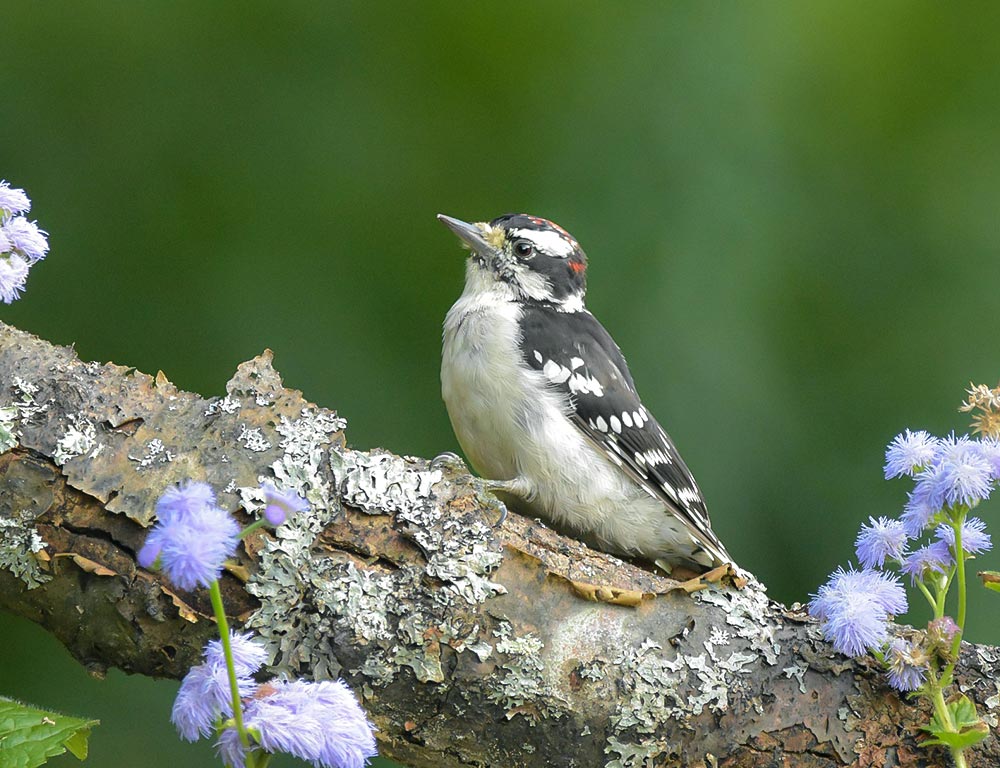
- Scientific Name: Picoides pubescens
- Life Span: Up to 5-6 years
- Size: 6-7 inches
- Weight: 1-1.2 ounces
- Food: Primarily insects, seeds, and berries
- Wingspan: 9-12 inches
- Status: Common
The Downy Woodpecker, with its black and white plumage, is the smallest woodpecker in North America.
Identified by a distinct red spot on the back of its head, males also have a small red patch on their nape. They are well-adapted to various habitats, including forests, parks, and suburban areas.
Downy Woodpeckers are highly acrobatic climbers, using their strong bills to drill into trees for insects, larvae, and eggs. Their drumming serves both to establish territory and attract mates.
During winter, they often visit backyard feeders, consuming suet and sunflower seeds. Despite their small size, Downy Woodpeckers are resilient and can endure harsh weather conditions.
2. Pileated Woodpecker
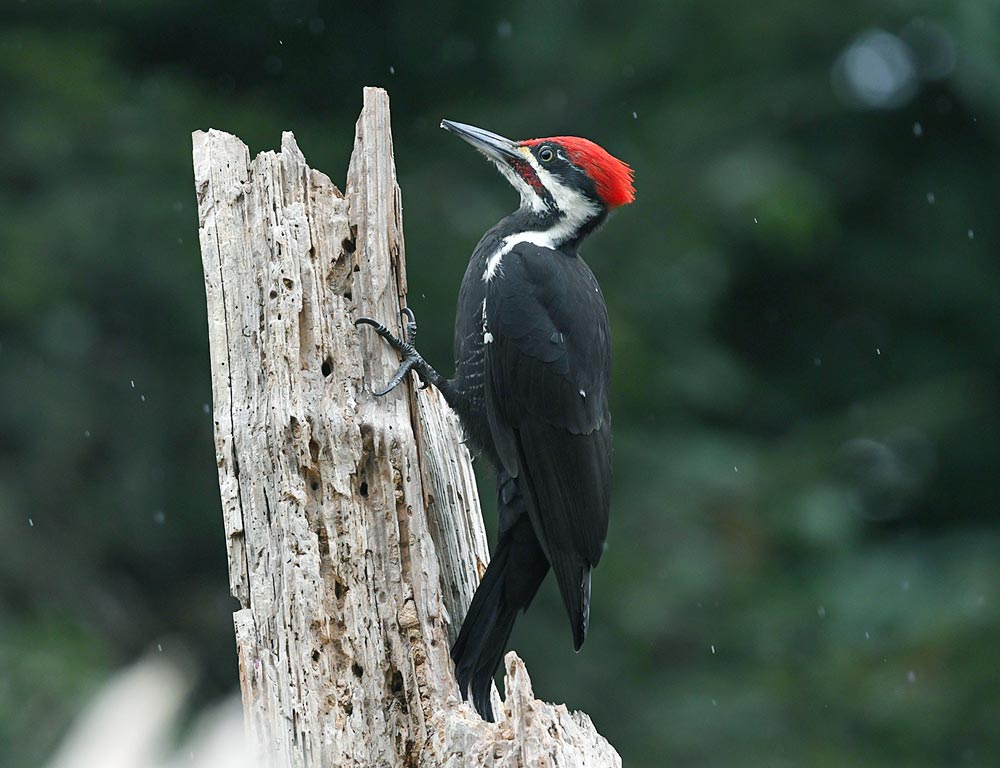
- Scientific Name: Dryocopus pileatus
- Life Span: Up to 10 years
- Size: 16-19 inches
- Weight: 8-12 ounces
- Food: Insects, especially carpenter ants, and fruits
- Wingspan: 26-30 inches
- Status: Common
The Pileated Woodpecker is an impressive bird with bold black and white plumage, a prominent red crest, and a long neck. Its large size and vibrant appearance make it a striking sight in Wisconsin’s forests.
Pileated Woodpeckers are powerful excavators, creating large rectangular holes in trees to find their preferred prey, carpenter ants.
They also consume fruits and berries. Known for their distinctive drumming and loud calls, Pileated Woodpeckers are often heard before they are seen.
They inhabit mature forests and are essential for maintaining the ecological balance by controlling insect populations.
3. Red-headed Woodpecker
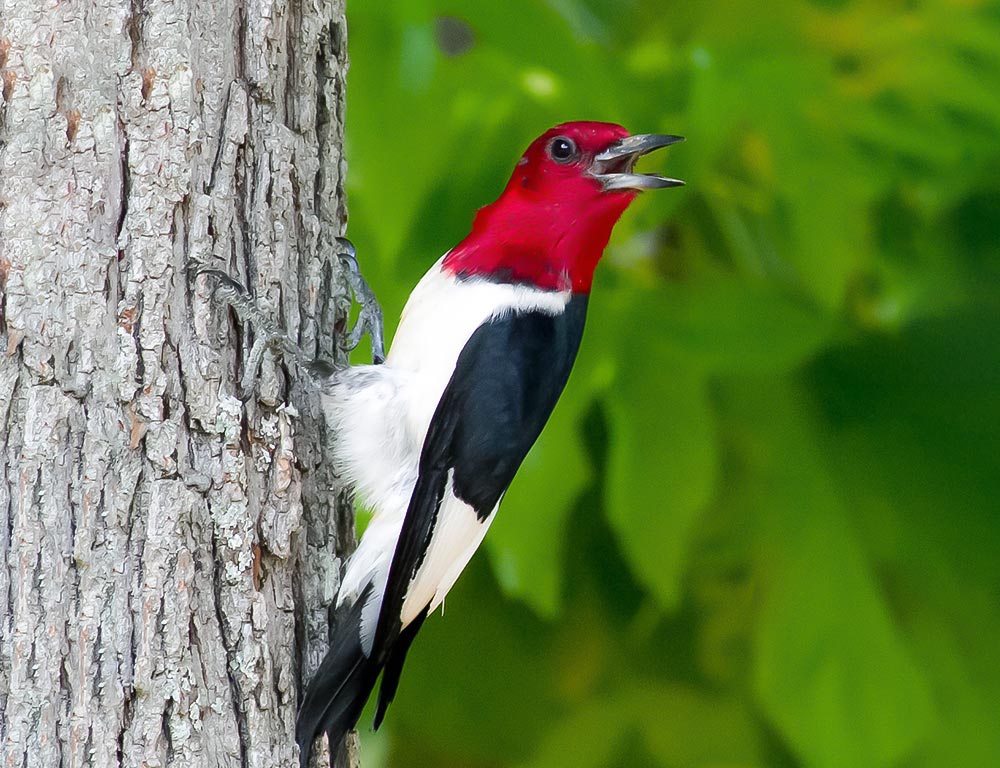
- Scientific Name: Melanerpes erythrocephalus
- Life Span: Up to 9 years
- Size: 7.5-9.1 inches
- Weight: 2.2-3.4 ounces
- Food: Insects, fruits, seeds, and occasionally small vertebrates
- Wingspan: 16.5 inches
- Status: Declining
The Red-headed Woodpecker is named for its striking crimson head, contrasting with its blue-black wings and pure white body. Unfortunately, their populations have been declining due to habitat loss.
Red-headed Woodpeckers are agile fliers and skilled catchers of insects in mid-air. They store surplus food by wedging it into bark crevices or impaling it on thorns.
Their unique behaviors and vibrant plumage make them a captivating species to observe. Conservation efforts are crucial to preserving their habitats and ensuring their continued presence in Wisconsin’s ecosystems.
4. Red-bellied Woodpecker
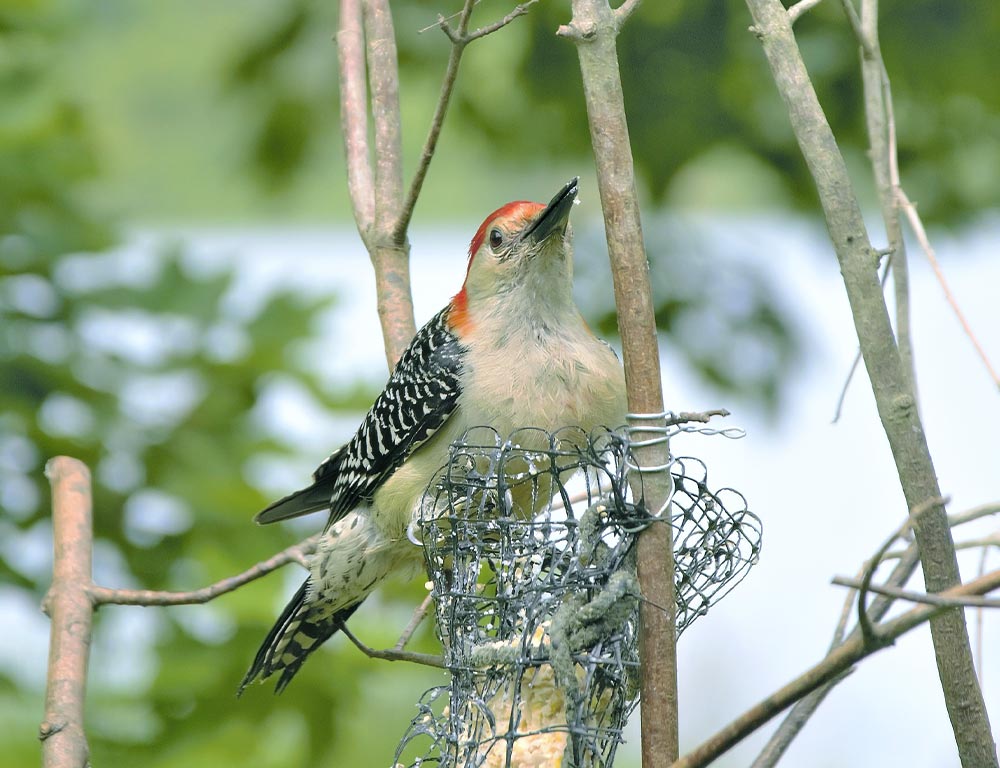
- Scientific Name: Melanerpes carolinus
- Life Span: Up to 9 years
- Size: 9-10.5 inches
- Weight: 2-3 ounces
- Food: Insects, fruits, seeds, and occasionally small vertebrates
- Wingspan: 13-16 inches
- Status: Common
Despite its name, the Red-bellied Woodpecker has only a faint reddish tinge on its belly, while its head showcases a vibrant red cap. Its back and wings are barred with black and white, making it a visually striking bird.
Red-bellied Woodpeckers are adaptable and can be found in various habitats, including woodlands, suburban areas, and parks. They are omnivores, feeding on insects, fruits, and seeds.
Their strong bills are well-suited for drilling into the wood to extract insects and sap. Red-bellied Woodpeckers are vocal, often emitting a distinctive “churr” sound, and are known for their agility and acrobatic maneuvers on trees.
5. Northern Flicker
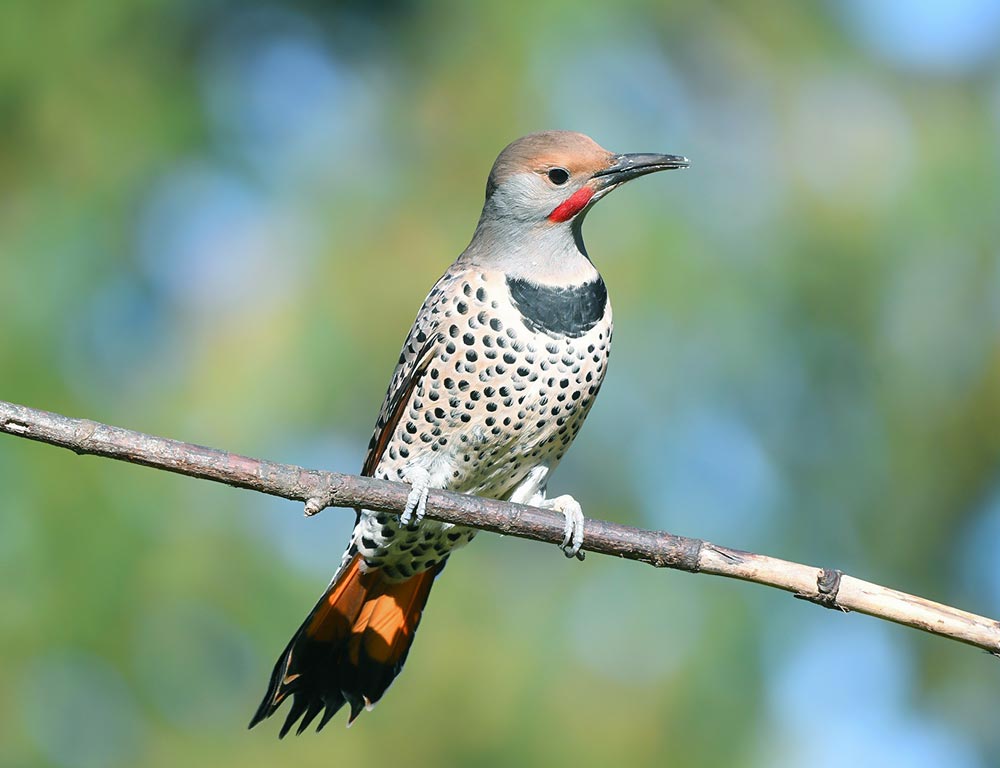
- Scientific Name: Colaptes auratus
- Life Span: Up to 9 years
- Size: 11-14 inches
- Weight: 3-5 ounces
- Food: Insects, especially ants, beetles, and seeds
- Wingspan: 16-20 inches
- Status: Common
The Northern Flicker is a medium-sized woodpecker with a unique appearance featuring a spotted brown body, barred black wings, and a distinctive crescent-shaped red mark on the nape.
They are often spotted on the ground foraging for insects. Northern Flickers are ground feeders, using their slightly curved bills to extract ants and beetles from the soil.
They are also known for drumming on metal objects like chimneys to communicate during the breeding season. These woodpeckers prefer open habitats like fields and meadows, in addition to wooded areas.
6. Yellow-bellied Sapsucker
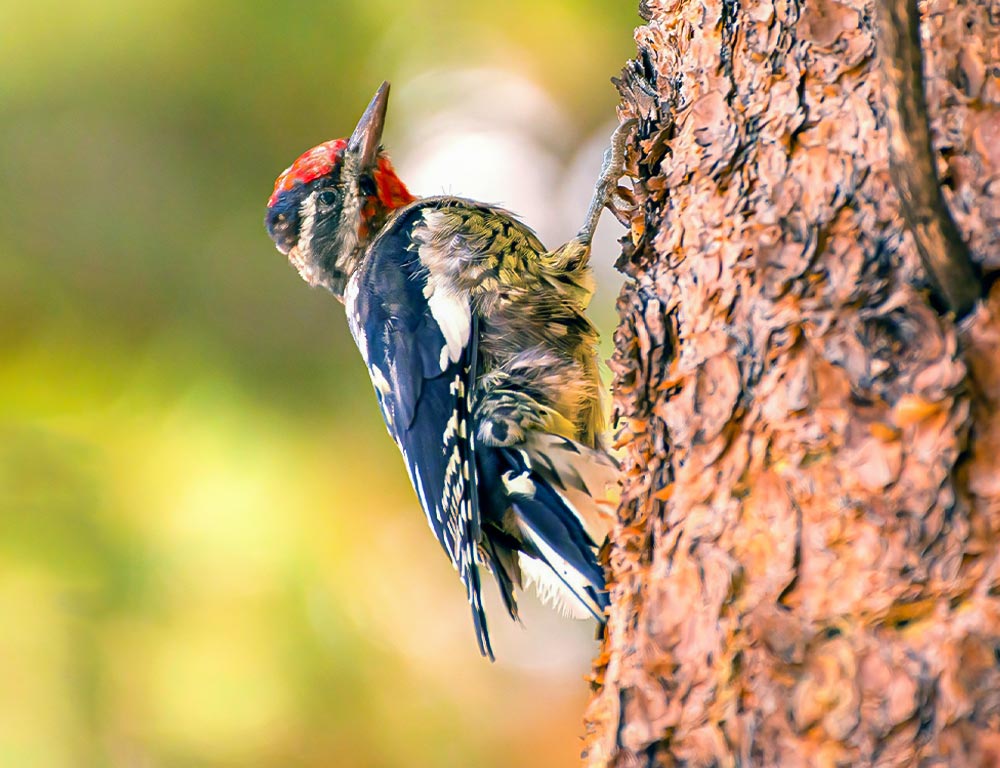
- Scientific Name: Sphyrapicus varius
- Life Span: Up to 10 years
- Size: 7-9 inches
- Weight: 1.5-2.5 ounces
- Food: Sap, insects, and tree fruits
- Wingspan: 13-16 inches
- Status: Common
The Yellow-bellied Sapsucker is known for its distinctive black and white plumage with a yellowish wash on its belly. These woodpeckers have a unique feeding behavior, drilling shallow holes in trees to consume sap.
Yellow-bellied Sapsuckers feed on the sap that oozes from the wells they create, and insects are attracted to the sap. They have a preference for deciduous trees, such as birch and maple.
During migration, they may be found in various habitats, including forests and orchards. Their presence can positively and negatively impact trees, as they contribute to nutrient flow but may also cause damage.
7. Black-backed Woodpecker
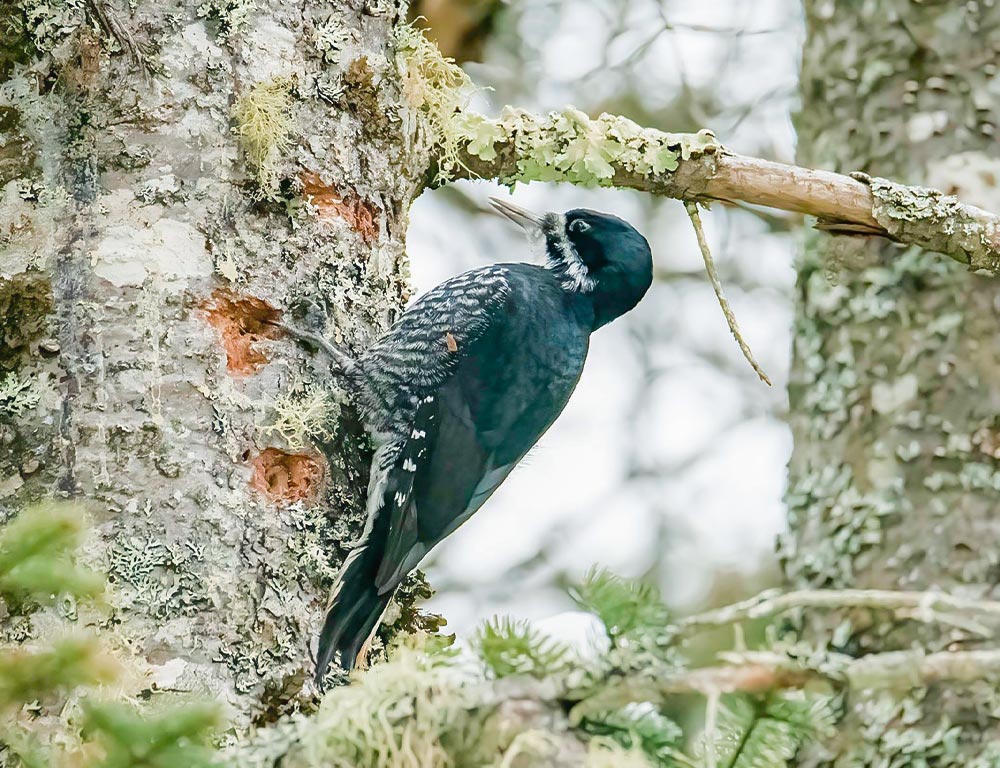
- Scientific Name: Picoides arcticus
- Life Span: Up to 9 years
- Size: 9-10 inches
- Weight: 2-3 ounces
- Food: Insects, especially wood-boring beetles and their larvae
- Wingspan: 15-18 inches
- Status: Uncommon
The Black-backed Woodpecker is a striking bird with black plumage and a white stripe down its back. Males have a yellow cap on their heads, while females have a black cap. They are well-adapted to boreal and subarctic forests.
Black-backed Woodpeckers specialize in foraging for insects on trees that have been affected by fire, preferring recently burned areas.
Their strong bills are adapted for excavating wood to access insects. They are relatively solitary birds and may be challenging to spot due to their preference for remote habitats.
8. American Three-toed Woodpecker
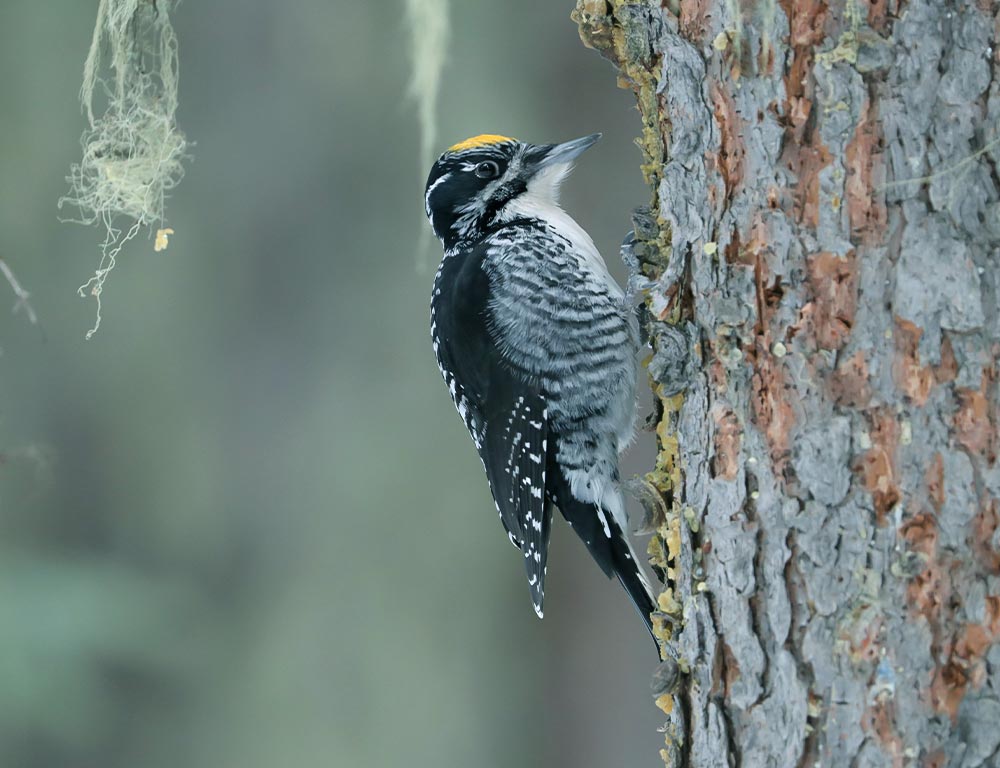
- Scientific Name: Picoides dorsalis
- Life Span: Up to 9 years
- Size: 8.5-9.5 inches
- Weight: 2-3 ounces
- Food: Insects, especially bark beetles and their larvae
- Wingspan: 15-16 inches
- Status: Uncommon
The American Three-toed Woodpecker is easily identified by its black and white plumage, with three toes instead of the usual four. Males have a yellow crown, while females have a black crown. They are typically found in coniferous forests.
These woodpeckers are adapted to feed on the larvae of wood-boring beetles that infest the bark of coniferous trees. They often move vertically up tree trunks in search of insects, using their specialized toes to grip the bark.
American Three-toed Woodpeckers are less vocal than some other woodpecker species, making them discreet residents of their preferred habitats.
9. Lewis’s Woodpecker

- Scientific Name: Melanerpes lewis
- Life Span: Up to 10 years
- Size: 10-11 inches
- Weight: 3-5 ounces
- Food: Insects, fruits, and occasionally sap
- Wingspan: 18-20 inches
- Status: Uncommon
Lewis’s Woodpecker is distinctive with its dark greenish-black plumage, pink-red face, and gray collar. Unlike other woodpeckers, it has a more relaxed and perching lifestyle, often observed sitting on exposed branches.
These woodpeckers have a unique foraging style, catching insects in mid-air like a flycatcher. They also consume fruits and occasionally sap.
Lewis’s Woodpeckers are often associated with open woodlands, particularly areas with scattered trees.
Conservation efforts are important, as their populations have been impacted by habitat loss and changes in fire regimes. Woodpeckers in Wisconsin play a crucial ecological role by controlling insect populations and aiding in forest health.
Their foraging habits, which include excavating wood for insects, contribute to tree vitality. Their drumming and nesting activities also create cavities used by various wildlife species.
As both predators and ecosystem engineers, woodpeckers contribute to the overall balance and biodiversity of Wisconsin’s forests, demonstrating the interconnectedness of these avian species within their ecological niche.
Wrapping Up
The woodpeckers of Wisconsin play vital roles in maintaining ecological balance, showcasing remarkable adaptations, and enriching our natural landscapes.
From the resilient Downy Woodpecker to the striking Pileated Woodpecker, these avian wonders embody the diversity and resilience of Wisconsin’s birdlife.
Whether drumming on trees or navigating the skies, each woodpecker species contributes to this region’s intricate web of life.
As guardians of forests, they demonstrate nature’s intricate harmony, urging us to appreciate and conserve their habitats. Thank you very much.